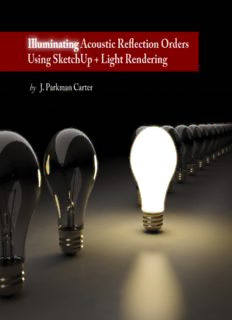
Illuminating Illuminating Acoustic Reflection Orders Using SketchUp + Light Rendering PDF
Preview Illuminating Illuminating Acoustic Reflection Orders Using SketchUp + Light Rendering
IIlllluummiinnaattiinngg Acoustic Reflection Orders Using SketchUp + Light Rendering by J. Parkman Carter © J. Parkman Carter 2016 This is a free e-book intended for educational and research purposes. You are free to share it (in unmodified form) with whomever you wish. This project was partially funded by a grant from the Robert Bradford Newman Student Award Fund in honor of Theodore John Schultz. The Schultz Grants provide partial funding for teachers or researchers interested in developing improvements in architectural educa- tion, and acknowledge the contributions of the late Dr. Schultz for his years of distinguished research contributions to the field of acoustics and for his dedicated service as a founding member of the Newman Student Award Fund Advisory Committee. The Newman Fund is sponsored by the Technical Committee in Architectural Acoustics in the Acoustical Society of America. All product names identified throughout this e-book are trademarks or registered trade- marks of their respective companies, and their use here is not intended to convey endorse- ment or other affiliation with this e-book. While reasonable care has been exercised in the preparation of this e-book, the author and the Acoustical Society of America assume no responsibility for errors or omissions, or for damages resulting form the use of the informa- tion contained herein. Copyright Disclaimer Under Section 107 of the Copyright Act 1976, allowance is made for “fair use” for purposes such as criticism, comment, news reporting, teaching, scholarship, and research. Fair use is a use permitted by copyright statute that might otherwise be infringing. Non-profit, educational or personal use tips the balance in favor of fair use. FAIR USE NOTICE: This e-book contains copyrighted material the use of which has not always been specifically authorized by the copyright owner. Such material is made available to advance understanding of ecological, political, human rights, economic, democracy, scientific, moral, ethical, and social justice issues, etc. It is believed that this constitutes a “fair use” of any such copyrighted material as provided for in section 107 of the US Copyright Law. In accordance with Title 17 U.S.C. Section 107, this material is distributed without profit to those who have expressed a prior general interest in receiving similar information for research and educational purposes. Contents Abstract v Acknowledgments vii How to view this interactive PDF ix 1. Introduction 1 1.1 Early Reflections 4 1.2 Image Source Method 7 1.3 Early Engineering Precedents 19 1.4 Art Precedents: “Infinite Rooms” 21 1.5 Caveats: Light vs. Sound 28 2. Method 31 2.1 SketchUp Modeling 32 2.2 Light Rendering with V-Ray 35 2.2.1 Reflective Mirror Material 36 2.2.2 Emissive Source Material 48 2.2.3 Receiver Position Camera 51 2.2.4 Render Quality Settings 53 2.2.5 Saving Renderings 55 2.2.6 Controlling Reflection Orders 56 2.2.7 Color-Coding Multiple Sources 59 2.3 360° Panoramic Renderings 63 2.3.1 Equirectangular Projection 63 2.3.2 “Hacking” V-Ray’s Camera Optics 66 2.3.3 QuickTime Virtual Reality (QTVR) 72 3. Conclusion 77 Image Credits 78 References 79 About the Author 80 v Abstract The conventional architecture workflow tends to—quite literally—“overlook” matters of sound, given that the modeling tools of architectural design are almost exclusively visual in nature. The modeling tools used by architectural acousticians, however, produce visual representations which are, frankly, less than inspirational for the design process. This project develops a straightforward scheme to visualize acoustic reflection orders using light rendering with the freely available and widely popular Trimble SketchUp 3D modeling software. In addition to allowing architectural designers to visualize acoustic reflections in a familiar modeling environment, this scheme also gives the acoustician a platform to invite designers into a deeper discussion about sound and architecture. A histor- ical background of the method and specific techniques will be presented. vii Acknowledgments This project has been generously supported by the Theodore John Schultz Grant for the Advancement of Acoustical Education (2014-2015 award). I also wish to thank students and faculty at Rensselaer Polytechnic Institute and Parsons School of Design for indulging this metaphor in sonic illumination. Figure 1: The first time you encounter a QTVR in this PDF, you will see the icon dis- played at left, and the interactive image likely will not open due to Adobe Reader permis- sions. You will see the warning above. Click Options > Trust this document always, and there- after you will see the QTVR. Figure 2: To interact with a QTVR, click and drag the left mouse button in the direction you wish to “steer” your view. You can look all around the 360° image, including above and below your point of view. ix How to view this interactive PDF This document is an interactive PDF that includes some features which may be unfamiliar to some readers. Embedded hyperlinks will appear in the familiar blue underlined format, and will take you to outside web references via your default internet browser. Figure 1-2 (pg. 5) is an embedded video file – simply click the image to play the video. The interactive images whose format may be unfamiliar to readers are the embedded QuickTime Virtual Reality (QTVR) files on pages 73 and 75. These are 360° spherical panoramic images which you can “steer” around in to see the entire scene from a fixed point of view. Interacting with QTVR files is similar to using Google Maps in Street View mode. The QTVR format will allow us to create immersive renderings of our spaces under study. The first attempt to use the interactive figures in this PDF may trigger Adobe Reader’s permissions warning. Please refer to Figures 1 and 2 on the opposite page to see how to apply the correct permissions and interact with the interactive 360° view.
Description: